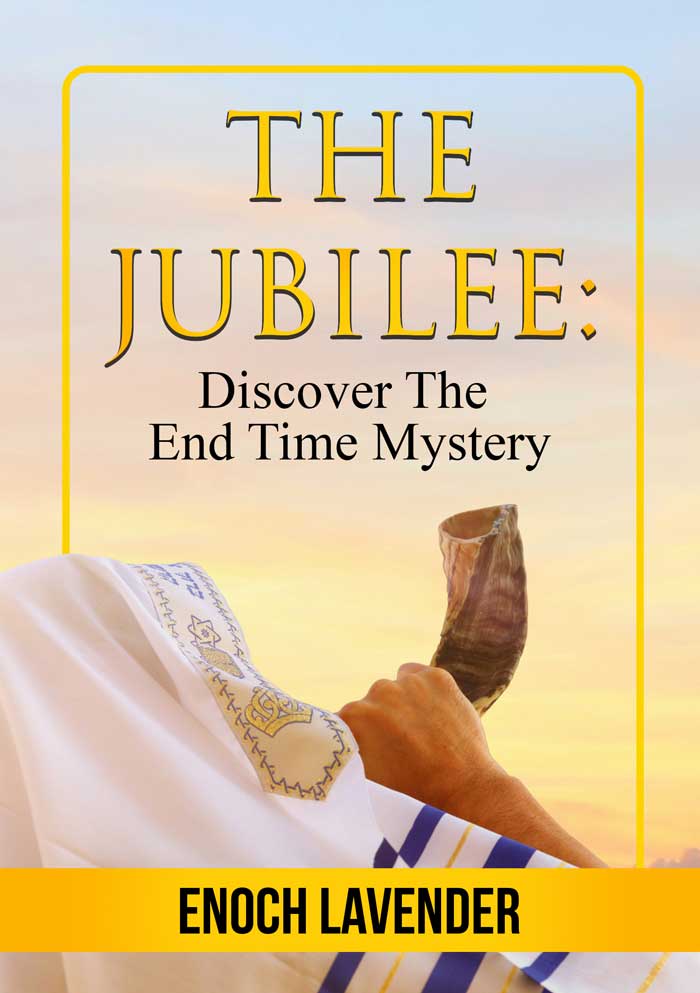The Jubilee: Discover The End Time Mystery
In this ground breaking book, join Ps Enoch Lavender as he uncovers key elements of the End Times from a fresh Messianic Perspective.

What topics are covered?
9
The Meaning of the Gospel in Jesus Day
9
The Jubilee Trumpet and Jesus Return
9
The Tremendous Hope of the Resurrection
9
The Final Ingathering of God’s People
9
The Kingdom to Come
9
The Restoration of all Things
Free Preview
Get your free preview of the book now
What People are Saying:
Barbara Miller
Reviewer
5/5
Enoch Lavender’s book The Jubilee: Discover the End Time Mystery looks at the gospel through a fresh lens of the jubilee and the kingdom of God and end time restoration and is well worth the read. Wh...
Show More
Show More
en Jesus announced His ministry, He was proclaiming the Jubilee, the release of the captives not just from the devil but from death. Pastor Enoch discusses with a personal story the joy of the Resurrection when the dead will rise with resurrected bodies like the one Jesus had when He arose from the dead. He speaks of the coming Messianic judgment as Jesus is also one who delivers the oppressed from their oppressors.
When the Kingdom of God comes on earth, then we will co-reign with Him. We will have work to do and won’t just be sitting around playing harps. The return of Jews to Israel is an important part of the Jubilee as well. Pastor Enoch brings together the concepts of Jubilee, the Resurrection of the Dead, the wedding banquet, and the Messianic Kingdom on earth together. They will be fulfilled at the sound of the Jubilee trumpet. We look forward to the restoration of all things and Pastor Enoch has done us a great service through this interesting book.
Show Less
Show Less
2 months ago
Anne Hamilton
Reviewer
5/5
A thorough but warmly accessible book, easy to read and rich with insight. The following understandings that impacted me most deeply.
One of the early points is that Jesus went around, according to...
Show More
Show More
Matthew 4:23, preaching the gospel of the kingdom. Clearly this could not be the message of His death, burial and resurrection, since these acts of salvation hadn't happened. Nor could this have been the message that the disciples delivered when they were sent out to preach the gospel. Instead it must have been the message of the Messianic Jubilee. (p9)
"In the Jubilee when God restores all things and brings His people back to their inheritance, then we too will be restored to life, returning from exile into our restored human bodies." (p34)
"The Messianic Judgement of our world is another key component of the promised Jubilee Redemption. To 'redeem' in Hebrew doesn't just mean 'to buy back' in terms of the Jubilee, but to 'pay back'." (p45)
There are parallels between the battle plan for the taking of Jericho and the Jubilee cycle. (p59)
The phrase "meet the Lord in the air" is used to describe a delegation leaving a city to meet an honoured guest on his approach. (p68)
Joel points out that the meal eaten by the seventy elders on Mount Sinai was a covenantal wedding banquet. (p69)
Cassius Dio recorded that 580,000 men were slain in the Jewish rebellion of the early second century. Those who died from famine, disease or fire was past finding out. (p72)
During the siege of Jerusalem in 1948, rationing was imposed at the level of a Japanese concentration camp. However unseasonal rain caused the nutritious weed khubeiza to sprout up. Local Jews exclaimed, "God is with us, like in the days of Egypt." (p77) The siege ended as Jerusalem was down to its last day's supply of bread and last 12 hours of electricity. (p78)
The Feast of Tabernacles is reminiscent of the pattern of the Jubilee cycle. (p85)
Jerusalem is a plural word, indicating there is more than one. (p106)
Show Less
Show Less
4 months ago
Charles Stokes
Reviewer
5/5
Reading The Jubilee: Discover The End Time Mystery has given me a greater understanding of end time events, seeing how they fit into the Jewish Feasts, and the words of the Old Testament Prophets. It ...
Show More
Show More
gives a much clearer picture of future events than what has been taught in most churches today.
This book needs to be read by all believers in the God of the Bible because it takes away the mystery of end time events, and replaces them with practical understanding. Thank you Enoch for this enlightening read and may God bless all who read it with a greater understanding of future events.
Show Less
Show Less
4 months ago
Sharron
Reviewer
5/5
The Jubilee: Discover The End Time Mystery is a well written treatise which challenges many of our current ideas about end time theology. Using his own research Enoch Lavender presents a clear and con...
Show More
Show More
cise argument about the role of the Jubilee and the Jewish people in the end times. This is a seriously interesting and thought-provoking argument which raises the possibility that there will indeed be a physical Messianic jubilee for Israel in the end times. Given the situation now playing out in the Middle East this is a timely book worthy of a read.
Show Less
Show Less
4 months ago
Arvie Garcia
Reviewer
5/5
Engaging and accessible, this book challenges conventional perspectives, making it a must-read for anyone intrigued by the profound mysteries of the end times. With a balanced blend of scholarship and...
Show More
Show More
spiritual insight, "The Jubilee" offers a fresh and thought-provoking perspective on a subject of eternal significance.
Show Less
Show Less
4 months ago
Get your Copy of The Jubilee Today
Get started by selecting your geographic location:
